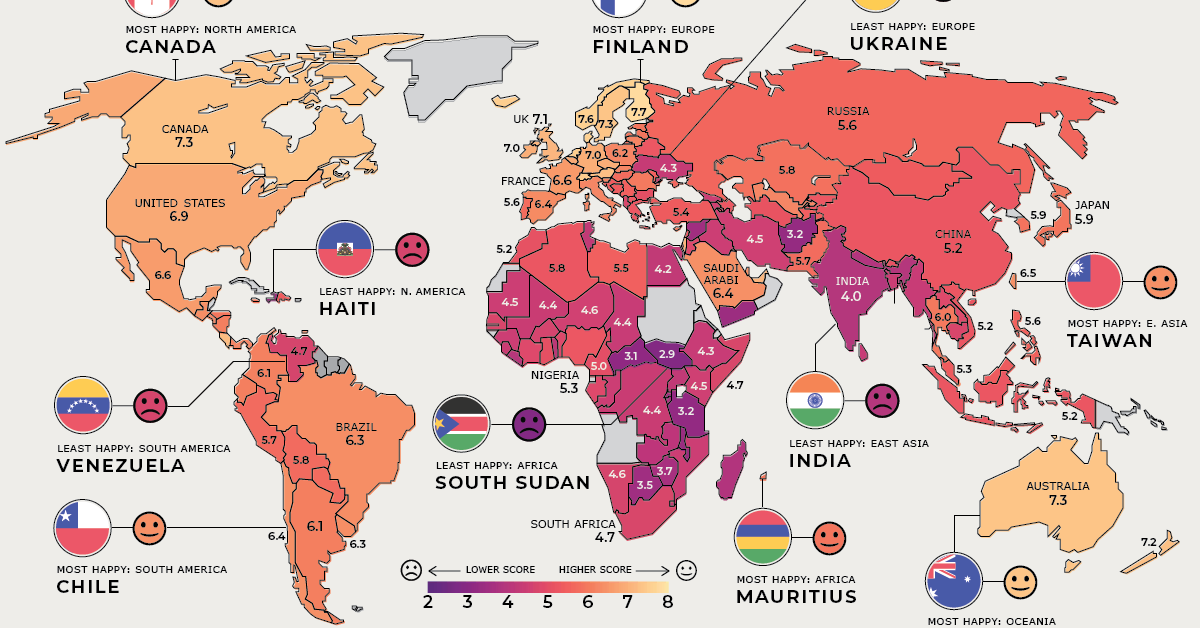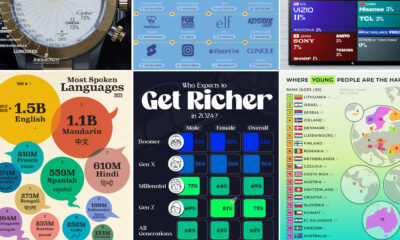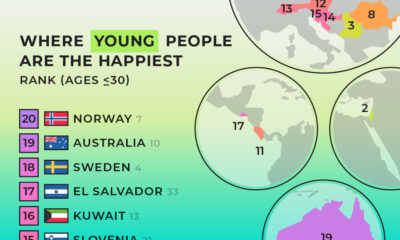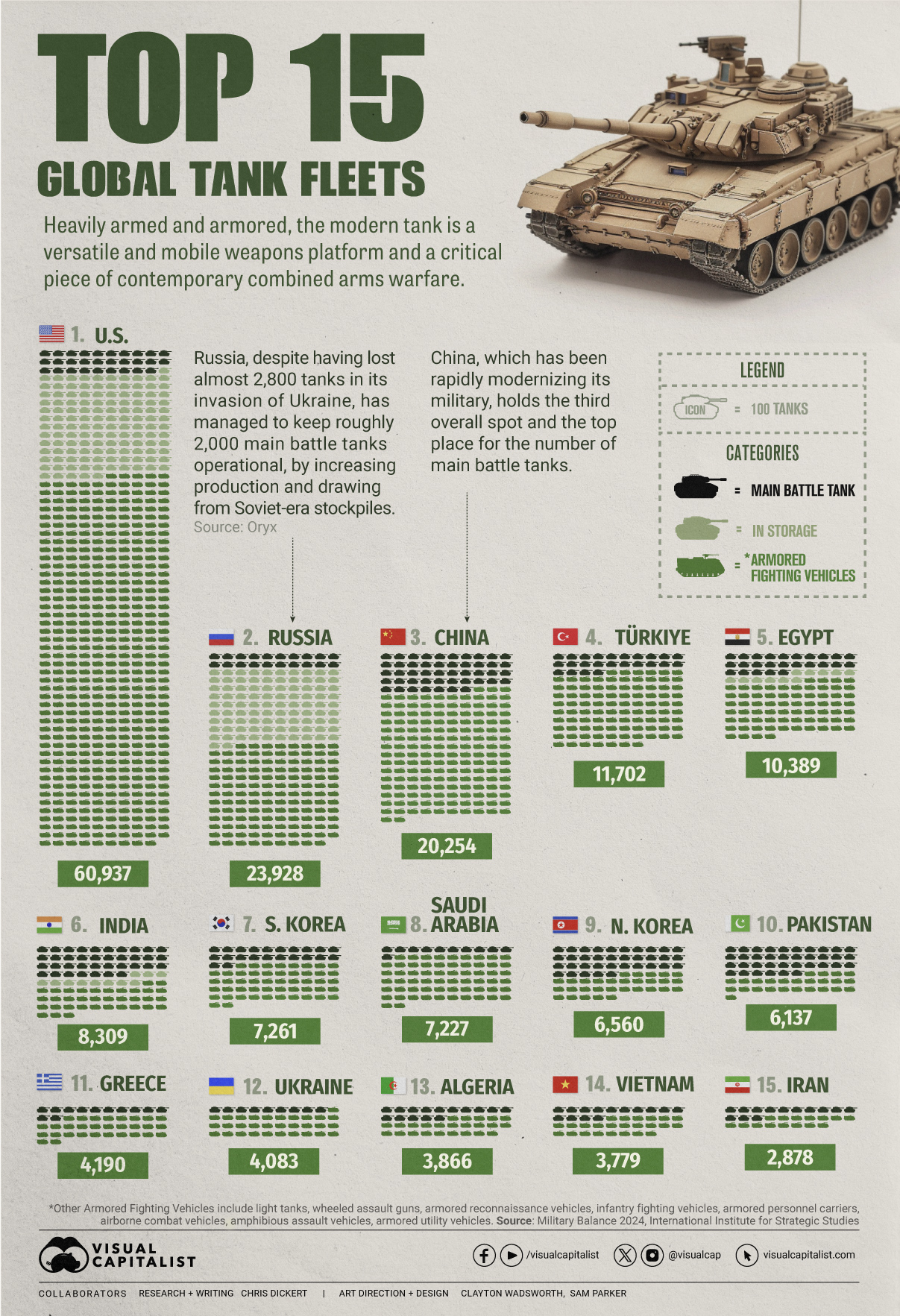Politics
Visualizing the Happiest Country on Every Continent
For the latest update, check out the happiest countries in the world in 2023.
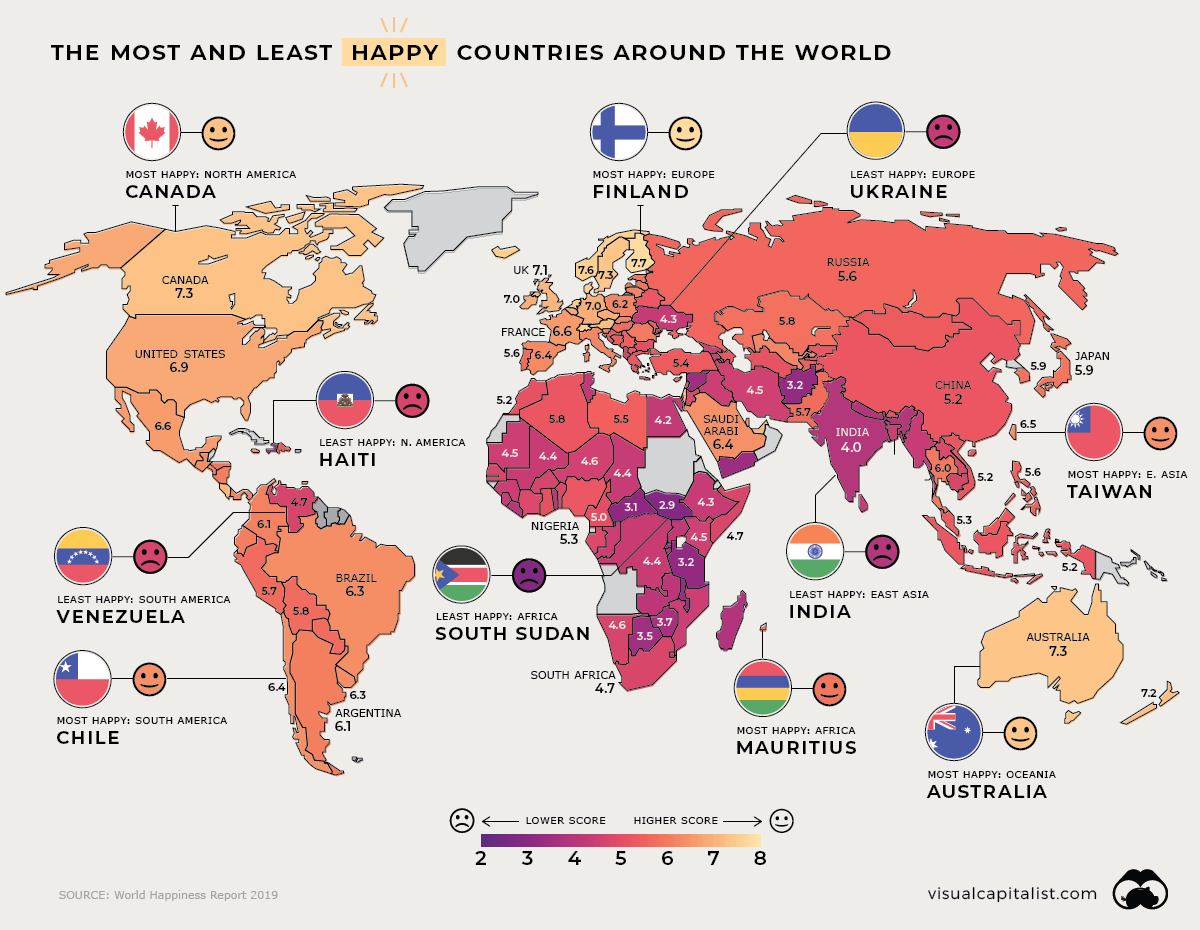
Visualizing the Happiest Country on Every Continent
For the latest update, check out the happiest countries in the world in 2023.
The state of our world is shifting beneath our feet — economics alone no longer equate to satisfaction, let alone happiness.
Today’s visualization pulls data from the seventh World Happiness Report 2019, which ranks 156 countries by their happiness levels. We’ve previously shown the variables used to measure happiness in this report, but here, we break down rankings by continent and region for a clearer picture of where each country lies.
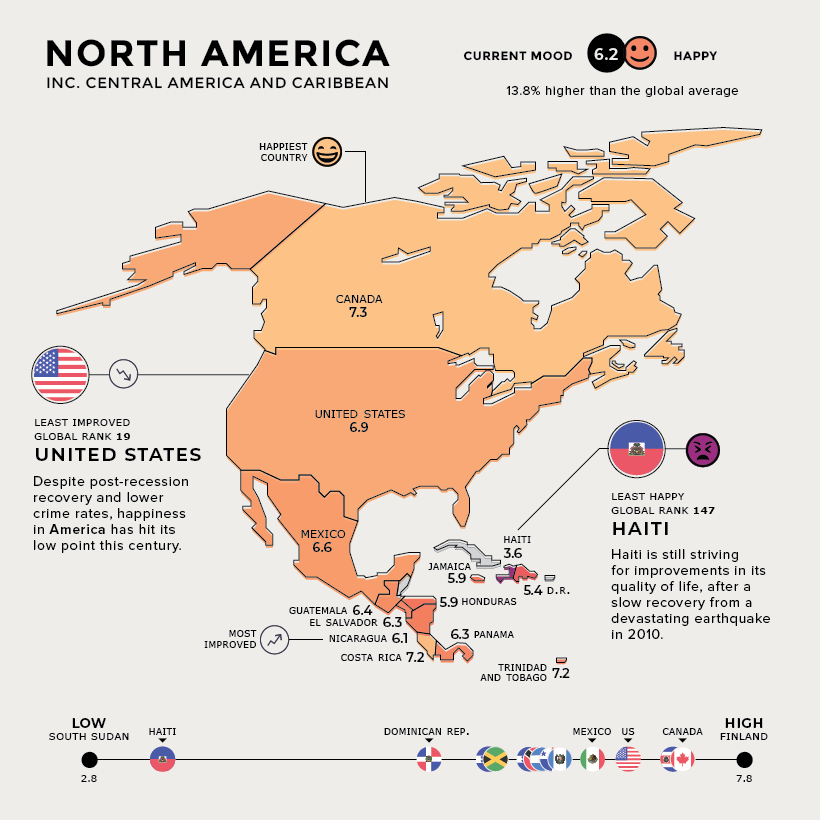
North America
Unhappy Americans have caused the country to tumble in rankings for a third straight year, despite evidence that things are generally looking up. The report attributes much of this erosion to a variety of addictions: opioids, workaholism, gambling, internet, exercise, and even shopping are among them.
Haiti is the least happy country in this region. The country is still struggling to rebuild sanitation infrastructure and other educational and healthcare programs, despite foreign aid.
In brighter news, Nicaragua is seeing great gains in happiness levels, as the country makes a concentrated effort to reduce poverty.
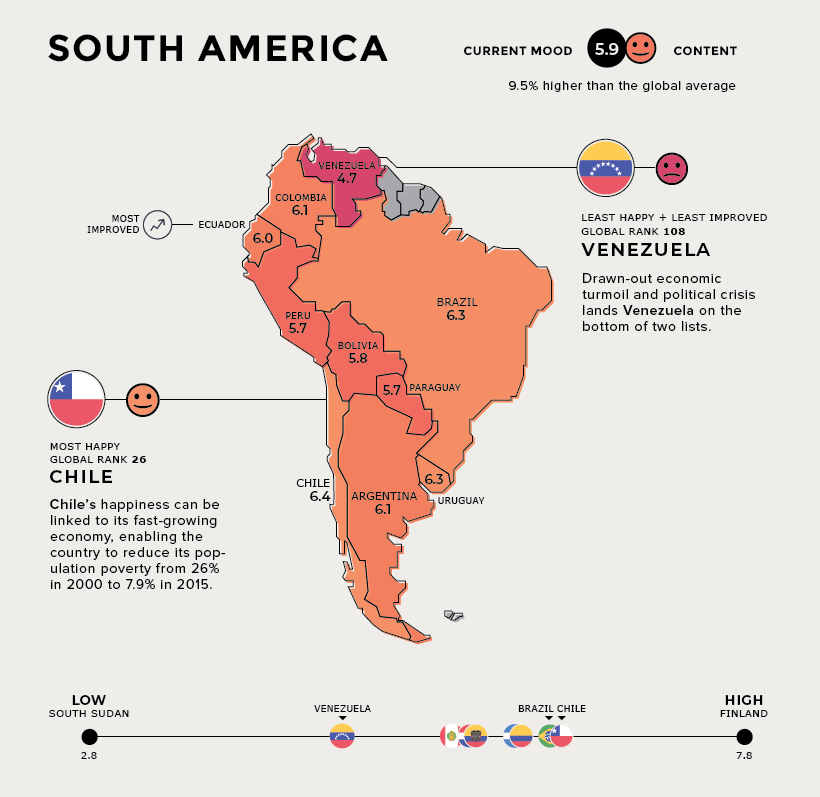
South America
In South America, the majority of countries cluster around a score of six on the happiness scale.
The one notable exception to this is Venezuela, which is faltering in both happiness rank and regional improvement. The nation’s hyperinflation and humanitarian crisis both show no signs of slowing down.
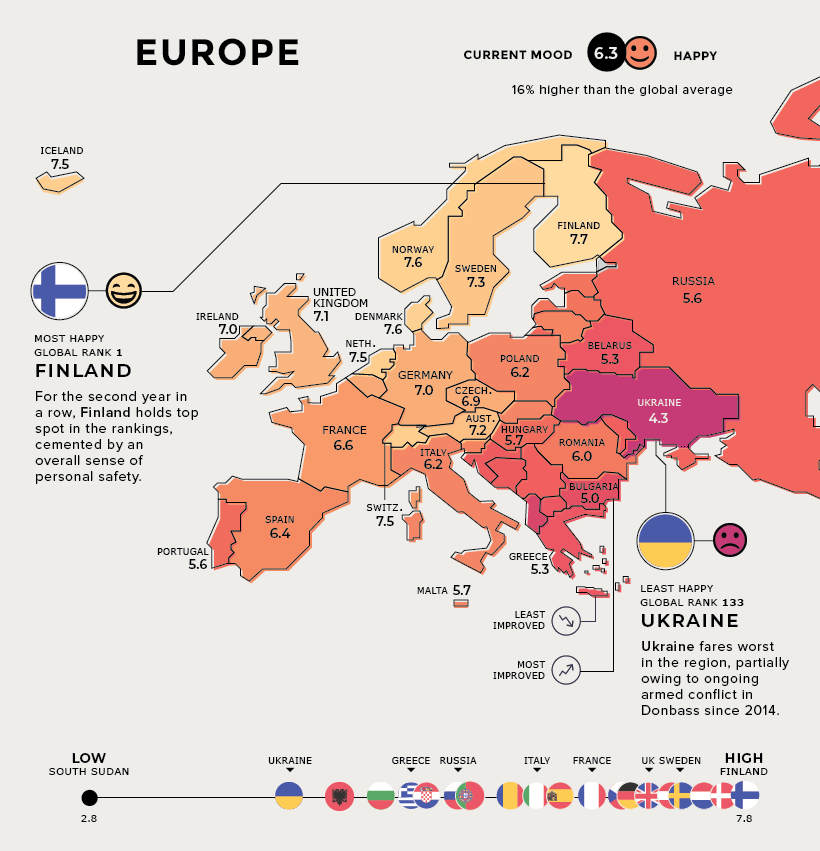
Europe
Finland comes out on top of the world for a second consecutive year, and it’s not difficult to see why. The country boasts a stable work-life balance, bolstered by a comprehensive welfare state.
Scandinavian countries appear among the happiest nations for similar very reasons — elevating the region’s score to 16% above the global average.
On the flip side, Ukraine is the unhappiest, likely intensified by the ongoing war in southeastern Donbass. Greece is the least improved, as it continues to heal from the sovereign debt crisis.
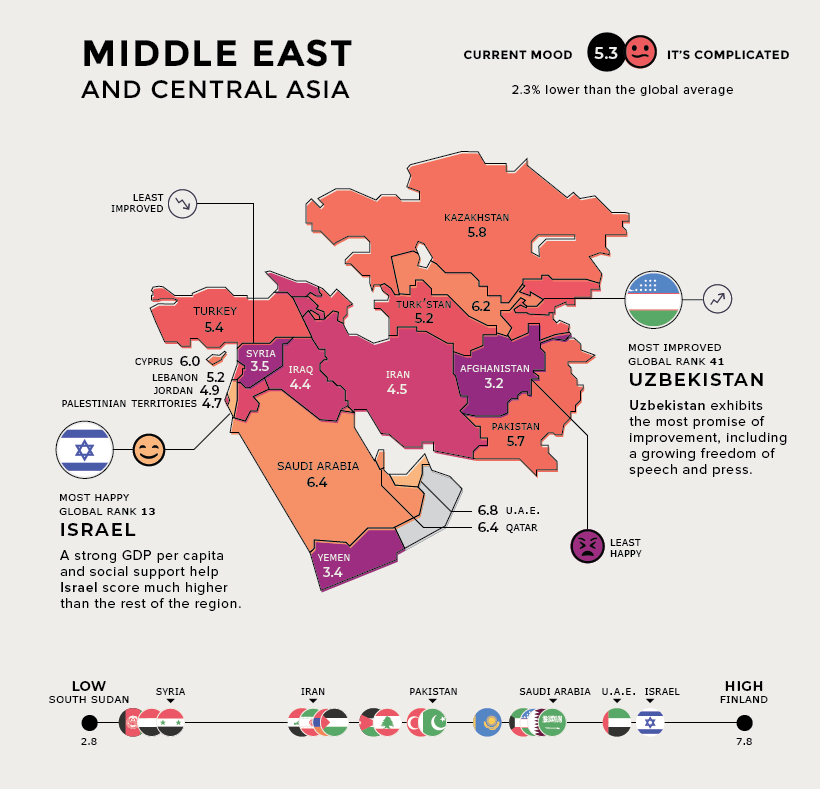
Middle East and Central Asia
Uzbekistan shows the swiftest regional improvement, as the country has launched an ambitious reform agenda for greater economic, social, and political development and openness.
Unfortunately, Syria’s continued civil war comes with a heavy price for its people and economy, as does the Palestinian-Israeli conflict — although the latter doesn’t seem to impact Israel’s happiness ranking. In fact, Israel finished with the 13th best score, globally.
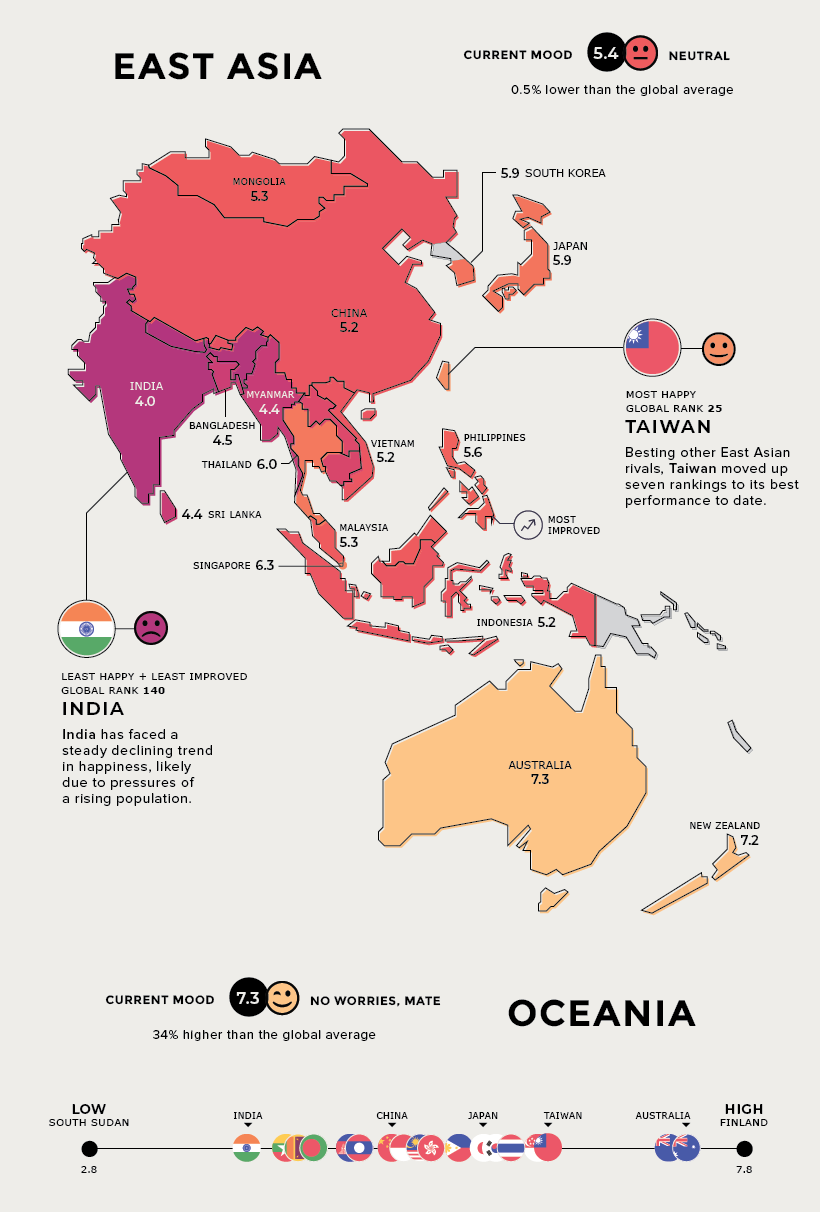
Rest of Asia and Oceania
In East Asia, the average happiness score is quite close to the global average, with Taiwan standing out as the happiest country.
Singapore out-competes other countries within Southeast Asia, despite only being home to a population of 5.6 million. Its neighbor Malaysia, however, plunged from 35th to 80th place.
Oceania stands alone – Australia and New Zealand are closely matched in their individual happiness scores.
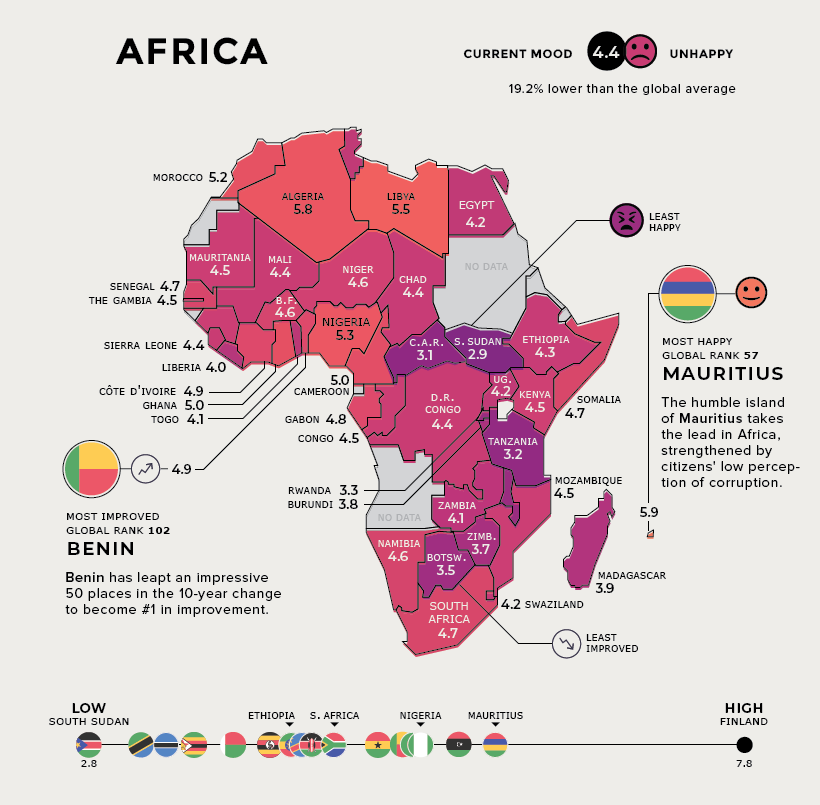
Africa
The African continent as a whole fares 19.2% below the global average. But there are silver linings, with strong strides towards improvement being made.
Mauritius benefits from good governance and a buoyant tourism sector — with visitor arrivals equal to the island’s 1.3 million population. Meanwhile, Benin has soared in the rankings, and is supported by the World Bank in key structural reforms such as poverty reduction and access to basic services.
What could these rankings look like in another ten years?
Notes: The Africa map was updated to show more country scores. The report only covers 156 countries, so “Oceania” only refers to Australia and New Zealand in this instance.
War
Visualized: Top 15 Global Tank Fleets
Heavily armed and armored, the modern tank is a versatile and mobile weapons platform, and a critical piece of contemporary warfare.
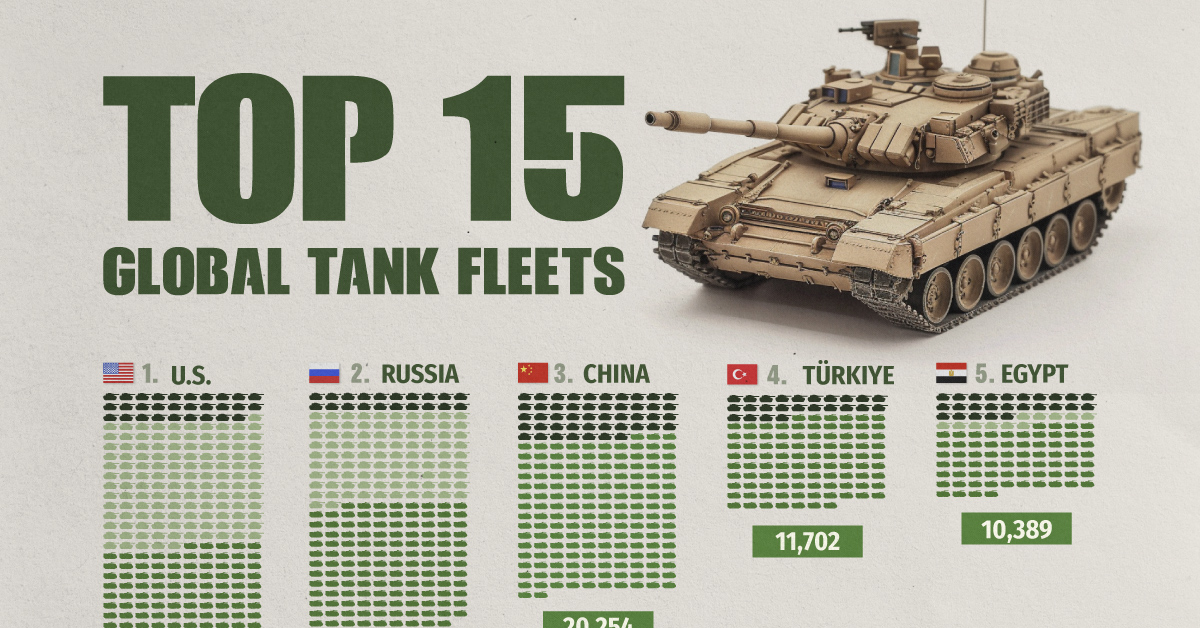
The Top 15 Global Tank Fleets
This was originally posted on our Voronoi app. Download the app for free on iOS or Android and discover incredible data-driven charts from a variety of trusted sources.
Heavily armed and armored, the modern tank is a versatile and mobile weapons platform, and a critical piece of contemporary warfare.
This visualization shows the top 15 global tank fleets, using data from the 2024 Military Balance report from the International Institute for Strategic Studies (IISS).
Let’s take an in-depth look at the top three fleets:
1. United States
As the world’s pre-eminent military power, it’s perhaps no surprise that the United States also has the largest tank fleet, by a wide margin.
In total, they have just over 45,000 armored fighting vehicles in operation, along with 2,640 main battle tanks (MBTs), and 12,800 vehicles in storage, of which 2,000 are main battle tanks.
| Category | Vehicles | Global rank |
|---|---|---|
| Main battle tanks | 2,640 | 4 |
| Armored reconnaissance | 1,745 | 1 |
| Infantry fighting vehicles | 3,262 | 3 |
| Armored personnel carriers | 10,644 | 1 |
| Amphibious assault vehicles | 1,401 | 1 |
| Armored utility vehicles | 28,445 | 1 |
| Storage | 12,800 | 1 |
| Total | 60,937 | 1 |
The U.S. is internalizing the lessons from the ongoing invasion of Ukraine, where Western-supplied anti-tank weapons and massed Ukrainian artillery have been cutting Russian tanks to pieces. As a result, the U.S. recently canceled an upgrade of the M1 Abrams in favor of a more ambitious upgrade.
Meanwhile, the U.S. is nervously eyeing a more confident China and a potential clash over Taiwan, where air and naval forces will be critical. However, a recent war game showed that Taiwanese mechanized ground forces, kitted out with American-made tanks and armored fighting vehicles, were critical in keeping the island autonomous.
2. Russia
According to Oryx, a Dutch open-source intelligence defense website, at time of writing, Russia has lost almost 2,800 main battle tanks since invading Ukraine. Considering that in the 2022 edition of the Military Balance, Russia was estimated to have 2,927 MBTs in operation, those are some hefty losses.
Russia has been able to maintain about 2,000 MBTs in the field, in part, by increasing domestic production. Many defense plants have been taken over by state-owned Rostec and now operate around the clock. Russia is also now spending a full third of their budget on defense, equivalent to about 7.5% of GDP.
At the same time, they’ve also been drawing down their Soviet-era stockpiles, which are modernized before being sent to the front. Just how long they can keep this up is an open question; their stockpiles are large, but not limitless. Here is what their storage levels look like:
| Category | 2023 | 2024 | YOY change |
|---|---|---|---|
| Main battle tanks | 5,000 | 4,000 | -20.0% |
| Armored reconnaissance | 1,000 | 100 | -90.0% |
| Infantry fighting vehicles | 4,000 | 2,800 | -30.0% |
| Armored personnel carriers | 6,000 | 2,300 | -61.7% |
| Total | 16,000 | 9,200 | -42.5% |
3. China
China holds the third overall spot and top place globally for the number of main battle tanks in operation. Untypically, the People’s Liberation Army has no armored vehicles in storage, which perhaps isn’t surprising when you consider that China has been rapidly modernizing its military and that stockpiles usually contain older models.
China also has one of the world’s largest fleets of armored fighting vehicles, second only to the United States. Breaking down that headline number, we can also see that they have the largest number of light tanks, wheeled guns, and infantry fighting vehicles.
| Category | Vehicles | Global rank |
|---|---|---|
| Main battle tanks | 4,700 | 1 |
| Light tanks | 1,330 | 1 |
| Wheeled guns | 1,250 | 1 |
| Infantry fighting vehicles | 8,200 | 1 |
| Armored personnel carriers | 3,604 | 5 |
| Airborne combat vehicles | 180 | 2 |
| Amphibious assault vehicles | 990 | 2 |
| Total | 20,254 | 3 |
This is equipment that would be integral if China were to make an attempt to reunify Taiwan with the mainland by force, where lightly armored mechanized units need to move with speed to occupy the island before Western allies can enter the fray. It’s worth noting that China also has one of the world’s largest fleets of amphibious assault vehicles.
End of the Tank?
Many commentators at the outset of Russia’s invasion of Ukraine, were quick to predict the end of the tank, however, to paraphrase Mark Twain, reports of the tank’s demise are greatly exaggerated.
With the U.S. and China both developing remote and autonomous armored vehicles, tanks could be quite different in the future, but there is nothing else that matches them for firepower, mobility, and survivability on the modern battlefield today.
-

 Real Estate2 weeks ago
Real Estate2 weeks agoVisualizing America’s Shortage of Affordable Homes
-

 Technology1 week ago
Technology1 week agoRanked: Semiconductor Companies by Industry Revenue Share
-

 Money1 week ago
Money1 week agoWhich States Have the Highest Minimum Wage in America?
-

 Real Estate1 week ago
Real Estate1 week agoRanked: The Most Valuable Housing Markets in America
-

 Business1 week ago
Business1 week agoCharted: Big Four Market Share by S&P 500 Audits
-

 AI2 weeks ago
AI2 weeks agoThe Stock Performance of U.S. Chipmakers So Far in 2024
-

 Misc2 weeks ago
Misc2 weeks agoAlmost Every EV Stock is Down After Q1 2024
-

 Money2 weeks ago
Money2 weeks agoWhere Does One U.S. Tax Dollar Go?

